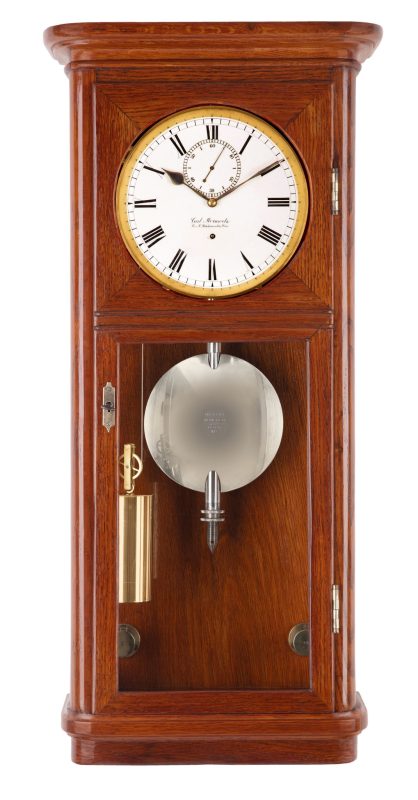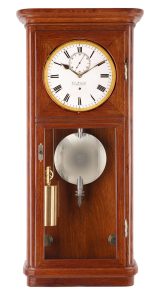Vienna, around 1910
- signed
- “Carl Morawetz, K. u. K. Hofuhrmacher, Wien”
- Clockmaker
- Karl/Carl Morawetz,
- Vienna, * 1842/43, 1866 Neubaugasse, 1900 Kohlmarkt, 1898 k.k. clockmaker to the court, † 1913
- Case
- polished oak wood
- Dial
- enamel
- Movement
- Graham escapement, maintaining power, off-center weight, jumping seconds, Riefler half-seconds-pendulum with temperature compensation stamped “Riefler München D.R.P. 100870 793”, duration of one week
- Height
- 23½ in
The Imperial and Royal court clockmaker Carl Morawetz was one of those gifted masters who carried the art of traditional 19th century Viennese clockmaking forward into the early 20th century and took it to new heights.
Morawetz founded his first branch in 1866, became court clockmaker around 1898 and opened his store at Kohlmarkt 11 in 1900, where the words “Kammeruhrmacher seiner Majestät des Kaisers und Königs, gegründet 1866” (Chamber clockmaker to his majesty the emperor and king, founded in 1866) still refer to the Morawetz clockmaking family today. Carl’s son Franz, born in 1872, worked side by side with his father, took over the business after his death in 1914 and was appointed Imperial and Royal chamber clockmaker. Probably the most well-known work by the Morawetz clockmakers is the famous “Ankeruhr”-clock on “Hoher Markt” square (1913/14), which is now one of the most visited sights in Vienna.
The wall-mounted regulator clock shown here combines the history of the renowned Viennese master with that of another ingenious clockmaker – Sigmund Riefler. Morawetz used a valuable “Riefler” pendulum for this timepiece. Developed by Sigmund Riefler in 1897, this type of pendulum made of invar, a nickel steel alloy resistant to temperature fluctuations, was revolutionary in terms of precision. This Riefler pendulum, a halfsecond pendulum with genuine temperature compensation, is marked “Riefler München D.R.P. 100870 793” on the back. The first six digits are the patent number, the last three the serial number of this prestigious piece of European clockmaking history.

